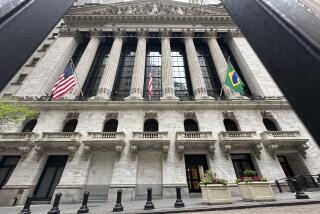Small Stocks Still the Big Story on the Street These Days
- Share via
If investors are troubled by rising interest rates, inflation jitters and the Clintons’ messy Whitewater affair, it isn’t showing up in prices of small-company stocks.
Key indexes of smaller stocks have been quietly creeping to new highs this week, even as the blue chip Dow industrial average, at 3,865.14 on Thursday, remains off 2.8% from its peak. The Nasdaq composite index of mostly smaller issues, for example, rose 4.86 points to a record 803.85 on Thursday, topping its previous peak of 800.47 set Jan. 31.
And the Russell 2,000 index, a purer measure of small stocks, hit its second consecutive record high Thursday, rising 0.68 point to 269.79. The Russell now is up 4.3% year-to-date, versus a 1% rise in the big-stock Standard & Poor’s 500 index.
Small stocks’ leadership actually is becoming an old story to investors who pay attention to this market sector: The Nasdaq and Russell indexes outpaced the gains in most blue chip stock indexes in 1991, ’92 and ’93. So despite periodic interruptions to their bull market, small stocks remain the market’s hottest longer-term story.
*
But why have small-company stocks been able to shake off the recent rise in interest rates so quickly, especially compared to bigger stocks? A few reasons, Wall Streeters say:
* Smaller companies’ earnings gains have been more robust as the economy has picked up steam. Claudia Mott, small-stock analyst at Prudential Securities in New York, says 1993 earnings of the Russell 2,000 companies were up 18% on average, versus a 12.7% rise for companies in the Russell 1,000 index of bigger stocks. The data covers companies reporting through the end of February.
Of all the variables that affect stock prices, only one is important in the long run, and that’s earnings growth. Interest rates matter far less.
* Many small health care stocks, depressed last year by worries about health care reform, have bounced back as the Whitewater affair has raised the odds that serious reform will be delayed. A lower level of Angst about the stocks also has allowed investors to recognize that many health care firms will win even with eventual reform, says Ron Elijah, manager of the Robertson Stephens Value Plus Fund in San Francisco.
Health care stocks, including such smaller names as nursing home operator GranCare and HMOs PacifiCare and Coventry, comprise about one-third of his fund, which is up 14% this year.
* Aggressive investors who were throwing dollars at international stock mutual funds in the second half of 1993 may be looking for alternatives closer to home, in the wake of many foreign markets’ sharp declines this year. Gary Pilgrim, whose Wayne, Pa.-based PBHG Growth small-stock fund is up about 7.5% this year, says his appearance on CNBC-TV earlier this week resulted in 8,000 investor calls for information.
Elijah, who was taking in $50,000 to $100,000 in fresh cash daily at the end of last year, has seen that balloon to $1 million to $1.5 million a day.
But the surging demand for smaller issues also is giving some pros pause. Keith Mullins, analyst at Smith Barney Shearson in New York, notes that, by far, the hottest sector of the small-stock market this year has been technology. Buoyed by continuing strong sales of computers and software, many tech firms’ 1993 earnings were terrific, setting off a frenzy for the stocks, Mullins says.
Yet tech stocks often follow a seasonal pattern, Mullins notes. And the seasonal peak for the stocks often comes in the spring--which means the current rally’s remaining days may be numbered.
Mullins also warns that broad small-stock indexes have gone 21 months without a 15% “correction,” or short-term pullback. The record period without a 15% pullback was a 24-month advance that ended in November, 1980, he says. So this rally is getting long in the tooth.
Even so, Mullins remains a long-term bull on small stocks, with or without a near-term correction. History shows, he says, that cycles of small-company leadership in earnings growth and stock performance tend to last longer than three years. And investors in the stocks tend to make the most money late in the cycle, he says, when speculation heats up and small-stock prices rocket to extraordinary levels relative to earnings.
One oft-used proxy for small-stock valuation is T. Rowe Price’s New Horizons stock fund. Today, the average price-to-earnings ratio of stocks in the fund, based on estimated 1994 earnings, is about 1.4 times the P-E of the blue chip S&P; 500. At small-stock peaks, Mullins says, the New Horizons P-E tends to be about 2.0 times the S&P; P-E. That suggests there’s room to run.
Small Is Profitable
Continuing the trend of the last three years, small-company stock indexes have led the market higher this year, despite the sharp upturn in interest rates.
Percentage change in price: Index 1992 1993 1994 Nasdaq indus. +8.3% +11.2% +5.7% Russell 2,000 +16.5 +17.0 +4.3 Nasdaq compos. +15.5 +14.8 +3.5 Dow industrials +4.2 +13.7 +3.0 S&P; mid-cap +9.5 +11.7 +2.7 S&P; 500 +4.5 +7.1 +1.0 Dow transports +6.7 +21.6 -0.8 Amex mkt. value +1.1 +19.5 -1.4 Dow utilities -2.3 +3.7 -9.5
More to Read
Inside the business of entertainment
The Wide Shot brings you news, analysis and insights on everything from streaming wars to production — and what it all means for the future.
You may occasionally receive promotional content from the Los Angeles Times.










